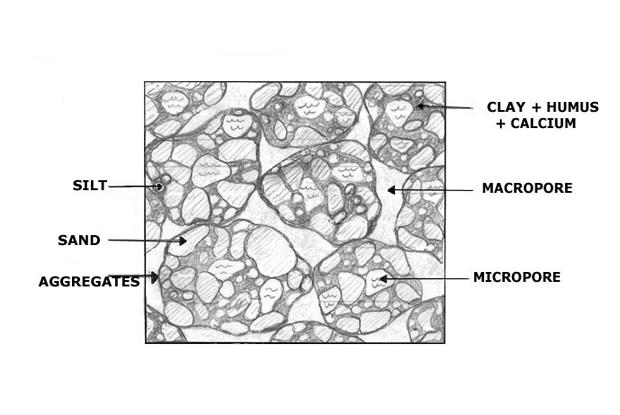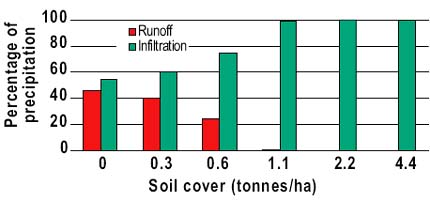And how does it apply to my soil?
The soil beneath our feet is teeming with diversity and life, which we understand comparatively little about:
“We know more about the movement of celestial bodies than about the soil underfoot.”
-Leonardo Da Vinci, circa 1500's
In order to properly understand the references below, an understanding of what good soil structure is is required:
Good soil structure
Soil structure refers to the way in which the sand, silt and clay particles are arranged relative to each other.

In soil with a good structure, the particles of sand and silt are held together in aggregates (small clumps) by clay, humus and calcium. The large empty spaces between the aggregates (macropores) allow water and air to circulate and plant roots to grow down into the soil. The small empty spaces (micropores) hold the water the plants need. This “ideal” structure is called granular, or crumbly. 4
A good soil structure is a prerequisite for satisfactory crop growth and adequate functioning of soil organisms. Soil structure supplies plant roots and soil organisms with “habitable pore space” and controls many processes, e.g., the transport of water, oxygen and nutrients. In turn, soil organisms can contribute to an optimum soil structure through aggregate formation and the creation of biopores. Soil organisms also play an important role in plant development, e.g., by supplying nutrients and by controlling pests and plant pathogens. Intensive soil tillage and traffic with heavy machinery can damage soil organisms and their habitats, and thus reduce their positive role. 1
For those looking for more in depth information on soil structure, a helpful resource with regards to soil management from the Montana State University can be found here.
Soil pores exist between and within aggregates and are occupied by water and air. Macropores are large soil pores, usually between aggregates, that are generally greater than 0.08 mm in diameter. Macropores drain freely by gravity and allow easy movement of water and air. They provide habitat for soil organisms and plant roots can grow into them. With diameters less than 0.08 mm, micropores are small soil pores usually found within structural aggregates. Suction is required to remove water from micropores. 2
Macropores, through which roots can generally proliferate readily, are much reduced in compacted soil. As a result, root growth is restricted or even inhibited. 3
Macropores are essential for transmission of water, oxygen and carbon in the soil, provide a habitat for earthworms and other beneficial soil organisms and allow easier growth through the soil for roots.
Micropores are tiny fissures, invisible to the human eye, usually in the aggregates of the soil. They are just as essential as macropores, as they store plant usable water.
Soil porosity refers to the fraction of the total soil volume that is taken up by the pore space. Mainly, pore spaces facilitate the availability and movement of air or water within the soil environment. … These pores influence soil biodiversity (i.e., soil microorganisms) by facilitating space for their survival. 7
Soil porosity is important for many reasons. A primary reason is that soil pores contain the groundwater that many of us drink. Another important aspect of soil porosity concerns the oxygen found within these pore spaces. All plants need oxygen for respiration, so a well-aerated soil is important for growing crops. Compaction by construction equipment or our feet can decrease soil porosity and negatively impact the ability of soil to provide oxygen and water. 8
Field capacity — the amount of water held in the soil after it has been fully wetted and free drainage has stopped. Water applied above this limit will make the soil saturated but water will drain quickly or be lost as runoff.
Permanent wilting point — the soil moisture condition at which the plant could not obtain water and has wilted and died. The crop cannot be revived by an irrigation or rainfall event.
Plant available water capacity (PAWC) — the amount of water between field capacity and permanent wilting point that is available to a plant. This requires careful management and depends on soil texture, structure and organic matter in the soil. 5
The soil's ability to store plant usable water is directly dependent on its compaction level. Since water is stored in soil micropores, the amount of micropores in the soil determines the amount of water the soil can absorb for plant use. If the soil is compacted, there is either no way for the water to get to the micropores, or the micropores have been destroyed. Either way, soil water holding capacity is reduced drastically, and so is plant growth.
A surface seal or crust is a thin layer (1−10mm) formed on the soil surface by water drop impact. It can have a porosity 90% lower than that of an unsealed soil. Permeability declines during rain or irrigation when the surface aggregates break down and are compacted under drop impact.
Surface sealing is largely responsible for restricted initial infiltration under rainfall or irrigation. Water that is unable to move into the soil profile will run off.
Sealing and crusting may be natural, or induced when soil cover is removed. 5
The proportion of rainwater that infiltrates into the soil depends on the amount of soil cover provided (Figure 12). The figure shows that on bare soils (cover = 0 tonnes/ha) runoff and thus soil erosion is greater than when the soil is protected with mulch. Crop residues left on the soil surface lead to improved soil aggregation and porosity, and an increase in the number of macropores, and thus to greater infiltration rates. 6
Figure 12:

Keeping a low maintenance cover crop or even stubble in the soil after the main harvest gives the surface of the soil some protection from the rain and allows it to more effectively rehydrate. If the fields are left bare, soil aggregates can break down, removing macropores and severely restricting transmission of air & water and the activities of soil organisms.
Compaction results in the breaking down of pores in the soil, killing off vital soil microorganisms & decreasing soil productivity.
Surface compaction is induced by tillage tool smearing, tractor wheels and farm animals.
This occurs when the soil is sheared or compressed at the critical moisture content known as the plastic limit.
Compaction results in high soil strength and reduced porosity, preventing water from accessing the root zone. In tilled soils, a plough pan can be created directly under the tilled layer by the smearing action of tines.
Compaction below the tilled layer (subsurface [or subsoil] compaction) is created by high axle loads under moist soil conditions. Water is unable to move freely through the soil profile. In dry conditions, subsurface compaction will prevent roots accessing deep stored moisture. 5
1 Developments in Agricultural Engineering Volume 11, 1994, Pages 215-235 - Effects of Compaction on Soil Biota and Soil Biological Processes
2 USDA Natural Resources Conservation Service in Soil Quality Indicators
3 J.J.H. van den Akker, B. Soane, in Encyclopedia of Soils in the Environment, 2005
5 Soil Properties - Soil Water, Queensland Government
6 Effect of soil organic matter on soil properties - Chapter 5
7 Soil organic carbon dynamics: Impact of land use changes and management practices: A review, Thangavel Ramesh, ... Oliver W. Freeman II, in Advances in Agronomy, 2019
Copyright. 2023 Rata Industries Group